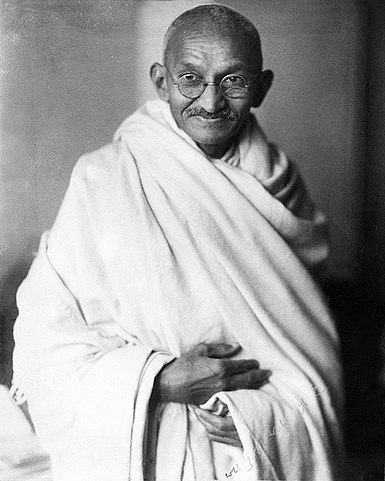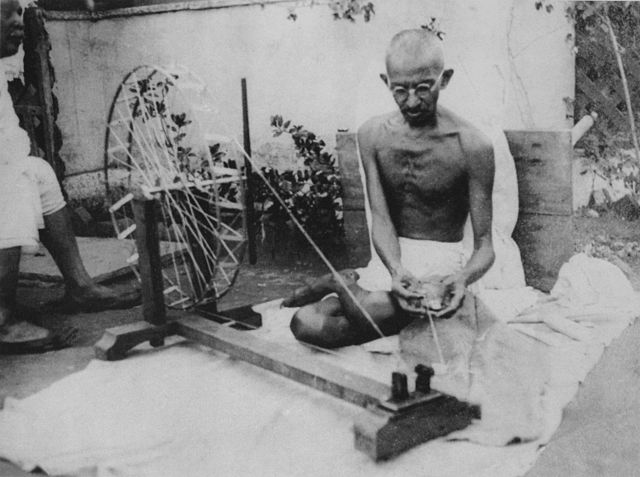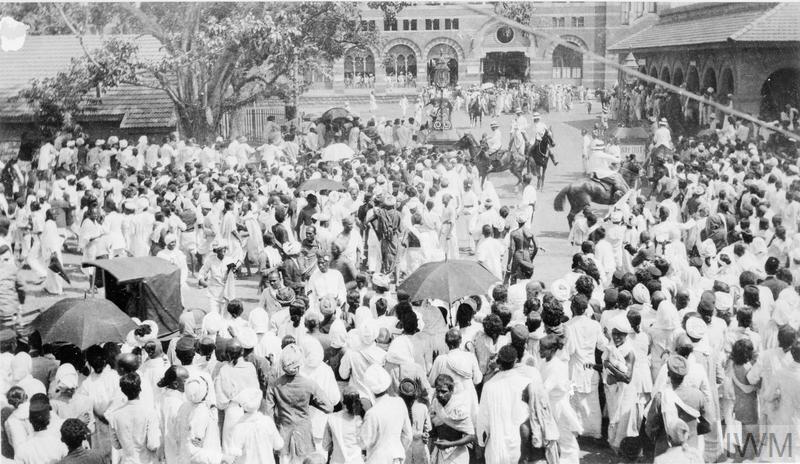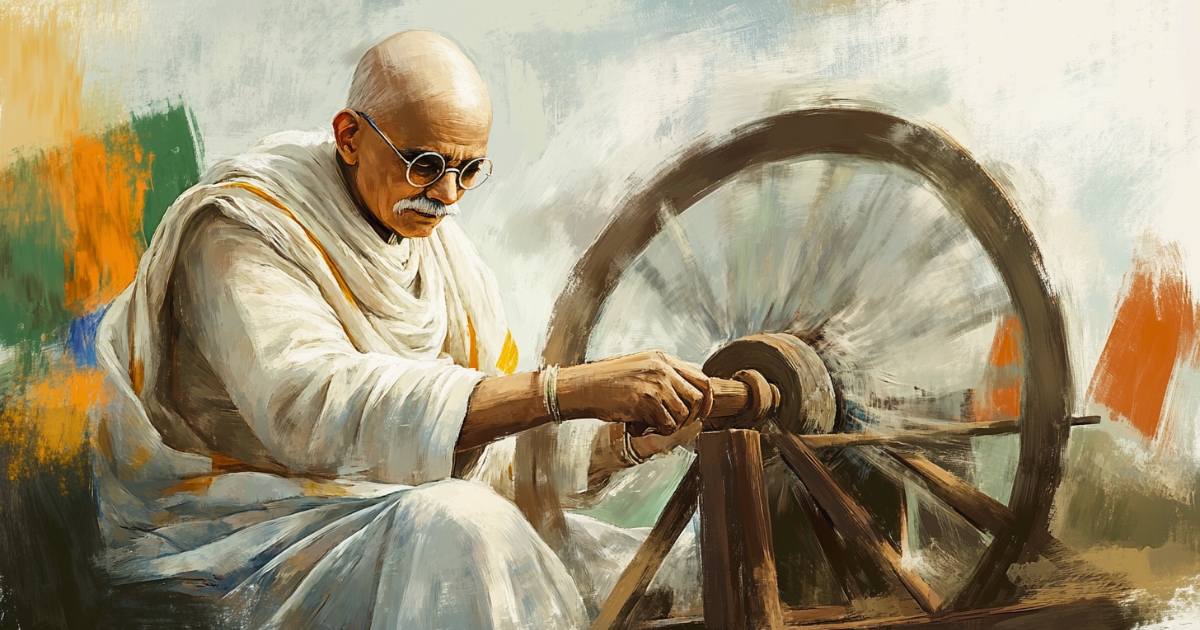In the first half of the 20th century, a simple tool became a powerful symbol of India’s independence movement. This was the spinning wheel, or “charkha,” beloved by Mahatma Gandhi. What appeared to be a mere handicraft tool became a potent weapon in India’s quest for independence and freedom. This article explores the political and social significance of Gandhi’s spinning wheel and its role in the Indian independence movement.

Mahatma Gandhi, embodying the philosophy of the spinning wheel and self-reliance, who led the Indian independence movement. He stands with a dignified expression, wearing white khadi attire. ©Elliott & Fry
- Historical Background: India Under British Colonial Rule
- Gandhi’s Encounter with the Spinning Wheel
- The Development and Objectives of the Khadi Movement
- The Influence of the Khadi Movement
- Gandhi’s Philosophy of Hand-Spinning
- Challenges and Criticisms of the Khadi Movement
- The Khadi Industry After India’s Independence
- Impact and Relevance to Contemporary Society
- Conclusion
Historical Background: India Under British Colonial Rule
In 1915, when Gandhi began to recognize the importance of the spinning wheel, India was under British colonial rule. This rule had a profound impact on India’s economy and society:
- Economic Exploitation: Britain used India as a source of raw materials and a market for manufactured goods. For example, in 1750, India accounted for 25% of global textile exports, but by 1900 this had fallen to less than 1%.
- Collapse of Rural Economy: British policies forced many Indian farmers to grow cash crops, leading to a loss of food self-sufficiency. The Madras famine of 1876-1878 is estimated to have caused about 5.2 million deaths.
- Decline of Traditional Industries: The influx of cheap British industrial products made it difficult for Indian artisans to make a living. Between 1811 and 1896, the population of Indian weavers steadily declined.
- Impact on Education and Culture: Britain introduced a Western-style education system, causing many Indian elites to drift away from traditional values.
It was in this context that Gandhi sought to achieve India’s economic and cultural independence through the spinning wheel.
Gandhi’s Encounter with the Spinning Wheel
Mahatma Gandhi encountered the spinning wheel, or “charkha,” and recognized its importance after 1915. Having returned to India after his human rights campaign in South Africa, Gandhi faced the problem of rural poverty.
Gandhi saw the spinning wheel as a means to address this situation. He believed that hand spinning and weaving using the charkha would not only promote rural self-reliance and economic independence but also become a symbol of spiritual independence and non-violent resistance. In 1917, Gandhi moved to the Sabarmati Ashram in Gujarat state, where he began actively promoting the use of the spinning wheel.

Mahatma Gandhi operating the charkha. This simple spinning wheel became a symbol of the Indian independence movement.
The Development and Objectives of the Khadi Movement
The hand-spinning and weaving movement proposed by Gandhi became known as the “Khadi Movement.” Khadi refers to hand-spun and hand-woven cotton cloth. This movement was not merely an economic activity but became an important part of the Indian independence movement.
The objectives of the Khadi Movement were as follows:
- Economic Self-Reliance: Provide supplementary income for rural people to help them escape poverty
- Gandhi calculated that using the charkha for 4 hours a day could generate an income of 15 rupees per month, which he argued would be a significant economic support for the rural poor.
- Spiritual Independence: Restore individual dignity and self-confidence by making one’s own clothes
- Gandhi preached that “Swaraj (self-rule) is attained through the charkha,” believing that hand-spinning would foster individual self-reliance.
- Revival of Cultural Identity: Revive traditional handicrafts and restore India’s cultural pride
- Gandhi praised India’s traditional textile techniques and positioned wearing khadi as an expression of Indian identity.
- Non-Violent Resistance: Demonstrate peaceful resistance to colonial rule through the boycott of British goods
- In 1921, Gandhi publicly burned foreign-made clothes and called for the wearing of khadi. This became a powerful symbol of non-violent resistance.
- Social Unity: Create a movement in which all Indians could participate, transcending caste and religious barriers
- Gandhi encouraged even high-caste people to engage in hand-spinning, promoting unity across caste lines.

Indian Boy Scouts waiting for the arrival of Bal Gangadhar Tilak, a leader of the Indian home rule movement, at Madras Central Station in 1917. During this period, young people were beginning to actively participate in the independence movement. Leaders like Tilak laid the foundation for the Khadi movement that Gandhi would later promote. © IWM
Gandhi imposed on himself the task of spinning for a set time each day, and many of his supporters followed suit. He raised the slogans of “Swadeshi” (use of domestic products) and “Swaraj” (self-rule), and wearing khadi came to signify participation in the independence movement.
The Influence of the Khadi Movement
The Khadi Movement spread throughout India at an astonishing pace. From the 1920s to the 1930s, khadi production increased dramatically and became established as a side business in many rural areas. Statistics show that by 1929, about 500,000 spinners and 100,000 weavers were involved in khadi production.
The impact of the movement was not limited to the economic sphere. Wearing khadi became a political act, demonstrating support for the independence movement, and became a symbol of the Indian National Congress. Intellectuals and artists impressed by Gandhi’s stance also began wearing khadi, and the movement spread to the urban middle class.
Gandhi’s Philosophy of Hand-Spinning
For Gandhi, the spinning wheel held a meaning beyond that of a mere tool. He found deep philosophical significance in the act of spinning.
The core of Gandhi’s hand-spinning philosophy consisted of the following points:
- Self-Sufficiency: Achieve material and spiritual independence by making one’s own clothes
- Non-Violence: Position the spinning wheel as a symbol of peaceful social change
- Equality: Encourage hand-spinning as an activity that anyone can do, regardless of caste or class
- Meditation: Find inner peace and harmony through the repetitive action of spinning
- Solidarity: Promote solidarity between rural and urban areas, and between the wealthy and the poor through hand-spinning
Gandhi said, “The spinning wheel is a symbol of our liberation from poverty and slavery.” For him, the spinning wheel was not just a tool, but a symbol of India’s independence and dignity.
Challenges and Criticisms of the Khadi Movement
While the Khadi Movement garnered significant support, it also faced challenges and criticisms:
- Quality and Productivity: Hand-spun and hand-woven products varied in quality and had lower productivity compared to factory-made products
- Cost: Khadi products were more expensive than factory-made products, making them less accessible to the poor
- Resistance to Modernization: Some intellectuals criticized the Khadi Movement as an obstacle to modernization and industrialization
- Women’s Labor Burden: Much of the khadi production was carried out by women, and there were concerns about the increased labor burden on them
To address these challenges, Gandhi and the movement’s supporters implemented measures such as technical guidance for quality improvement and ensuring appropriate compensation for producers.
The Khadi Industry After India’s Independence
After India’s independence in 1947, the khadi industry continued to exist under government protection. The “Khadi and Village Industries Commission (KVIC)” was established to support khadi producers and promote product sales.
However, with the progress of industrialization, the khadi industry gradually declined. From the 1980s onward, competition with cheap factory-made products intensified in the wave of globalization.
Nevertheless, khadi did not disappear completely. Rather, with the growing interest in ethical consumption and sustainability in the 21st century, there has been a movement to re-evaluate khadi.
Impact and Relevance to Contemporary Society
The philosophy of Gandhi’s spinning wheel and the Khadi Movement continues to have a significant impact on contemporary society. This influence is seen not only in India but around the world.
Ethical Fashion
- India: The “Khadi and Village Industries Commission” is developing khadi products with modern designs, gaining support from younger generations.
- International Influence: Gandhi’s ideas were precursors to the “slow fashion” movement. For example, they have influenced the philosophy of brands like “People Tree” in the UK and “Patagonia” in the US, which consider environmental and labor issues.
Slow Life Movement
- Japan: Organizations like “Slow Life Japan” are attempting to apply Gandhi’s ideas to modern life.
- International Influence: The “Slow Food” movement, which began in Italy, resonates with Gandhi’s idea of self-sufficiency. This movement has now spread to over 160 countries.
Local Production for Local Consumption
- India: Each state is making efforts to promote local khadi products.
- International Influence: Initiatives such as the “Farmers’ Market” movement in the US and the “Protected Geographical Indication” system in France, which support local producers, align with Gandhi’s idea of local economic self-reliance.
Re-evaluation of Handicrafts
- There are movements worldwide to revive traditional handicrafts, with many being registered as UNESCO Intangible Cultural Heritage.
- For example, activities to preserve traditional weaving techniques in the Andean region of Peru and the re-evaluation of Japan’s “monozukuri” (craftsmanship) culture resonate with Gandhi’s philosophy of handwork.
Non-Violent Resistance Movements
- Gandhi’s philosophy of non-violent resistance has influenced human rights activists worldwide, including Martin Luther King Jr. (USA), Nelson Mandela (South Africa), and Aung San Suu Kyi (Myanmar).
- In recent years, Gandhi’s ideas can be seen in environmental movements such as “Extinction Rebellion,” which conducts non-violent direct action against climate change.
Furthermore, in Indian politics, Gandhi’s ideas and khadi continue to hold an important position. Every year on October 2nd, Gandhi’s birthday, the Prime Minister and other politicians wear khadi to demonstrate their commitment to carrying on his spirit.
Conclusion
Gandhi’s spinning wheel became more than just a tool; it became a symbol of India’s independence movement. It was a powerful weapon with complex meanings: economic self-reliance, spiritual independence, revival of cultural identity, and non-violent resistance.
While the Khadi Movement faced many challenges in practice, the ideals Gandhi envisioned – self-sufficiency, non-violence, equality, inner peace, and solidarity – continue to provide important insights in modern society without fading.
In our contemporary world of globalization and mass production and consumption, the “philosophy of handwork” symbolized by Gandhi’s spinning wheel offers a valuable perspective for reconsidering our way of life and consumption patterns.
Gandhi’s ideas suggest concrete solutions to various challenges faced by modern society:
- Environmental Issues:
Gandhi’s idea of “living with minimal necessities” can be an answer to modern environmental problems. For example, the philosophy of the Khadi Movement suggests a sustainable lifestyle of “wearing fewer clothes for longer periods” as a solution to the problems of fast fashion.
- Economic Inequality:
Gandhi’s idea of creating side jobs through handwork resonates with modern concepts of the gig economy and micro-businesses. Promoting small-scale economic activities rooted in local communities could potentially help reduce economic disparities.
- Mental Stress:
The meditative aspect that Gandhi found in the act of spinning can be applied to mental health care for modern people. The idea of finding peace of mind through handwork is similar to the practice of mindfulness.
- Social Division:
The social unity across caste and religion that the Khadi Movement aimed for presents a solution model for today’s divided society. The experience of working together for a common purpose has the potential to strengthen social cohesion.
- Dependence on Technology:
Gandhi’s handwork philosophy sounds a warning against excessive dependence on technology. It reminds us of the value of human creation and suggests the importance of balancing technology with human capabilities.
As these applications show, Gandhi’s spinning wheel and the ideas it symbolizes are not relics of the past. Rather, they present simple yet powerful solutions to the complex challenges facing modern society.
Gandhi’s ideas continue to be inherited and evolve in various forms in the modern world, such as ethical fashion, the slow life movement, local production for local consumption initiatives, and non-violent resistance movements. These movements are important steps towards realizing a sustainable society.
Finally, I would like to conclude this article with a quote from Gandhi: “Be the change you wish to see in the world.” These words suggest that individual actions have the power to change society. The “accumulation of small actions” symbolized by Gandhi’s spinning wheel is the driving force that brings about great change.
We can learn from Gandhi’s legacy, adapt it to the modern context, and move forward towards building a more just and sustainable society. Just as the simple act of spinning the wheel brought about the great change of India’s independence, our individual small actions can become the force that spins a better world.


